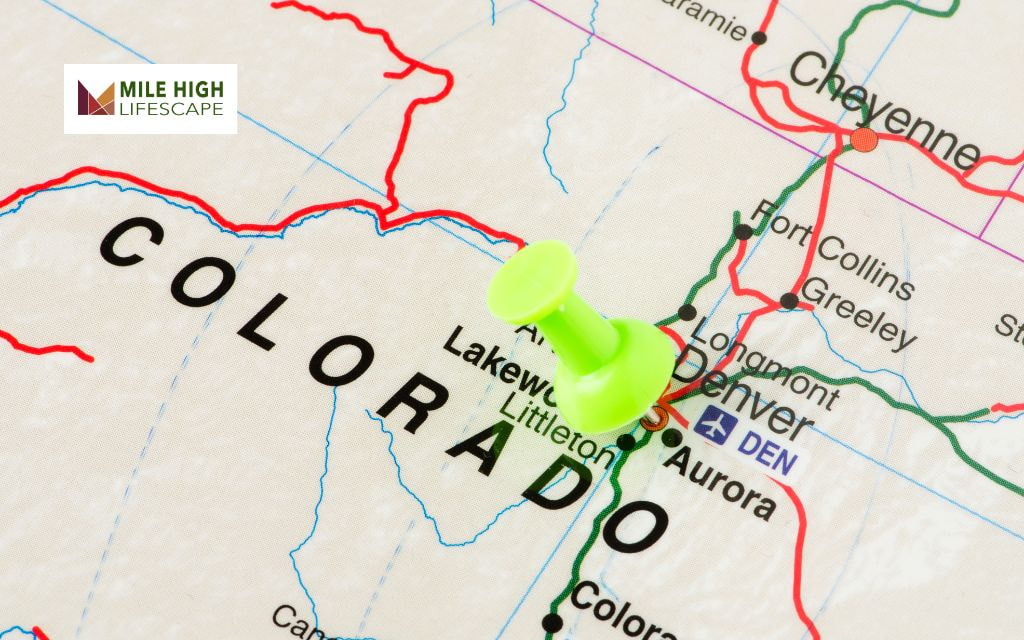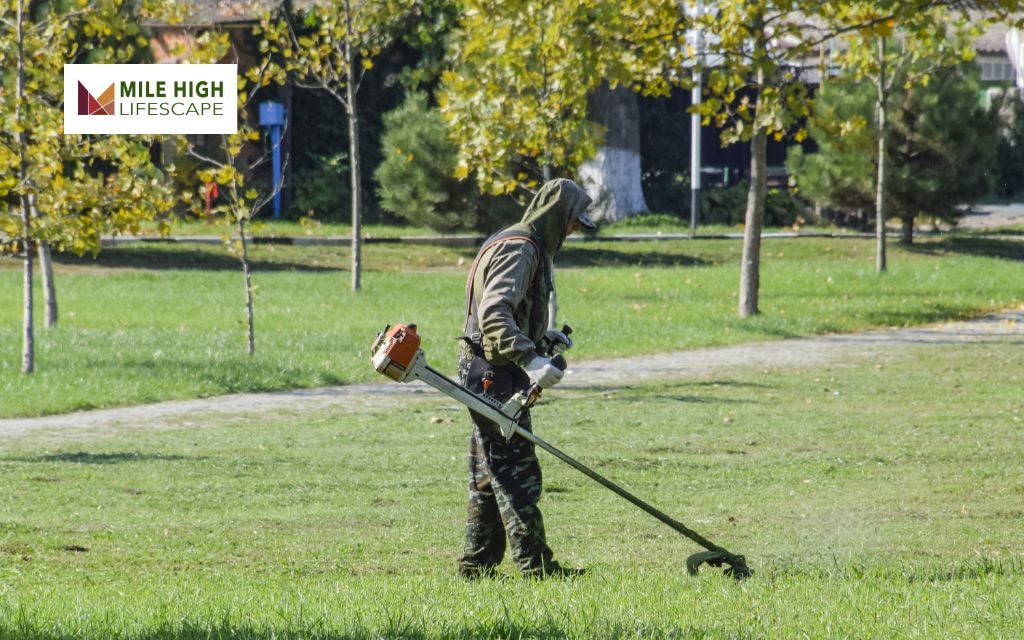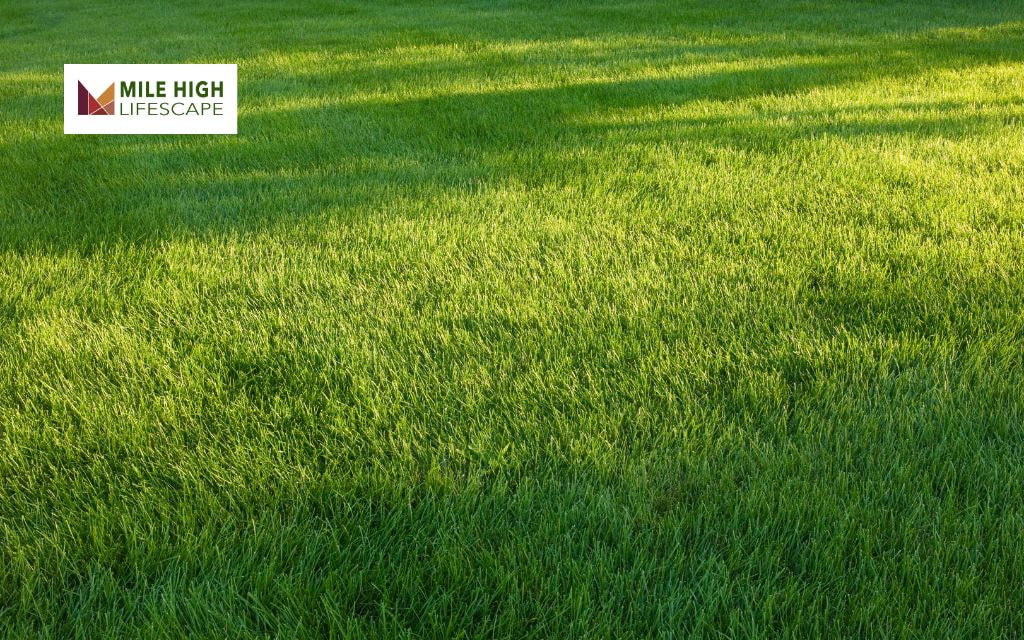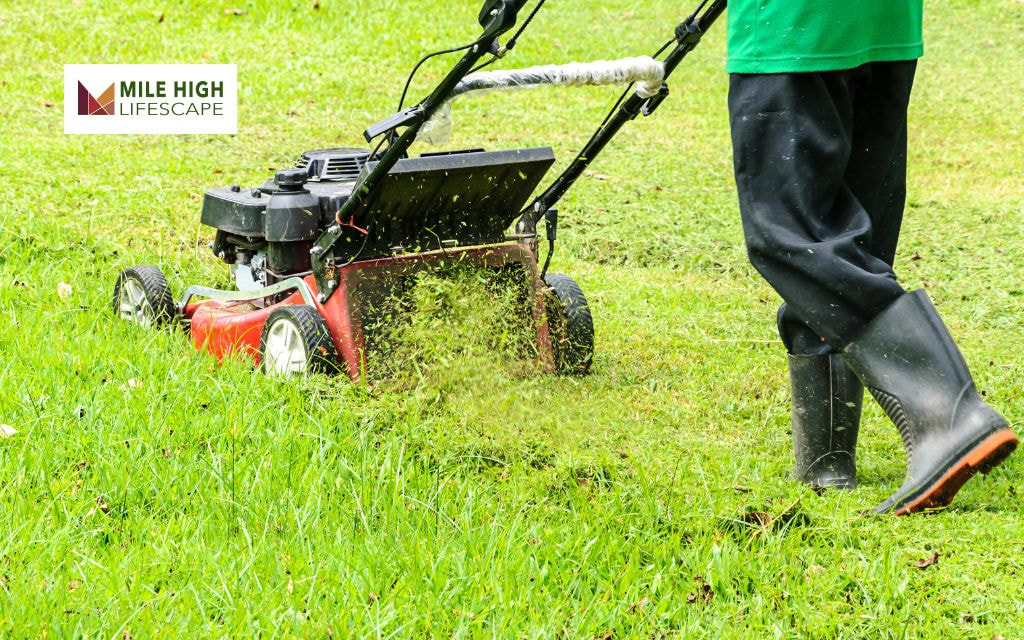Is your lawn ready for spring, or are you about to destroy it with your mower? Denver homeowners face a lawn care dilemma that outsiders just don’t understand.
When exactly should you make that first cut? Get it wrong, and you might as well pour weed killer directly on your turf. What hidden signs is your lawn sending that you’re completely missing? What if everything you’ve been taught about spring lawn care is backwards?
In this comprehensive guide, we’ll explore the optimal timing for spring lawn mowing in Denver, identify key indicators that your lawn is ready for its first trim, and provide seasonal mowing schedules to keep your grass healthy year-round. Are you ready to achieve the envy-worthy lawn you’ve always wanted?
Understanding Denver’s Climate
Denver’s unique climate creates specific challenges for lawn maintenance that require a different approach than other regions:
Semi-Arid Conditions:
- 300+ days of sunshine annually
- Low humidity (typically 30-40%)
- Higher evaporation rates than precipitation
- Turfgrass experiences more stress than in humid regions
Temperature Extremes:
- Winter lows frequently below freezing, forcing complete grass dormancy
- Summer highs often exceeding 90°F, stressing even drought-resistant varieties
- 30°F+ temperature swings possible within 24 hours
Unpredictable Seasonal Transitions:
- Spring can deliver 70°F one day and snow the next
- Freeze-thaw cycles confuse grass out of dormancy only to damage it with late frosts
- Last frost dates typically range from late April to early May
Snowmelt Considerations:
- Melting snow creates deceptively soggy soil conditions
- Lawns may appear dry on top while remaining waterlogged underneath
- Can delay safe mowing times well into spring despite warming temperatures
Understanding these climate factors helps determine when your lawn is truly ready for that first mow rather than following generic lawn care calendars designed for other regions.

Ideal Timing for the First Mow
The Denver Spring Mowing Window
- Primary Timeframe: Mid-March to early April is the sweet spot for most Denver properties
- Flexibility Required: This window shifts based on that year’s specific weather patterns
- Early Exceptions: Unusually mild winters might allow mowing as early as late February
- Late Exceptions: Harsh or extended winters could delay first mowing until mid-April
Why Calendar Dates Fail Denver Lawns
The key mistake many homeowners make is adhering strictly to the calendar rather than observing their lawn’s actual growth patterns. Your grass needs to fully emerge from dormancy and establish active growth before that first cut. Mowing too early can stress grass that hasn’t fully awakened and established sufficient root energy reserves, potentially setting your lawn back weeks in its development cycle.
When to Mow Your Lawn Depending on the Season
When to Mow Lawn in Spring (March – May)
As Denver transitions from winter to spring, begin mowing when grass consistently reaches 2.5-3 inches across most of your lawn and soil temperatures stabilize above 50°F.
Initially, mow every 5-7 days, adjusting as growth accelerates with warming temperatures. In early spring, set your mower slightly higher than summer height to encourage deep root development.
Always avoid mowing when grass is wet from morning dew, rain, or melting snow, as this can lead to clumping, uneven cuts, and potential disease spread. By late spring (May), Denver lawns typically require mowing every 3-4 days during peak growth periods.
When to Mow Lawn in Summer (June – August)
As hot, dry summer conditions set in, raise your mower height to 3-4 inches. This higher cut provides critical shade to the soil, reducing evaporation and helping roots stay cooler.
During summer, growth patterns often become less predictable due to heat stress and watering restrictions. During non-drought conditions, maintain a weekly mowing schedule.
However, during drought or when temperatures consistently exceed 90°F, your lawn may enter a semi-dormant state with slower growth – reduce mowing frequency to every 10-14 days while never removing more than one-third of the blade height. Mow during cooler morning or evening hours to reduce stress on both the grass and your mower.

When to Mow Lawn in Fall (September – November)
Fall lawn care requires strategic mowing adjustments. As temperatures cool in September and October, gradually lower your mowing height from the summer maximum to approximately 2-2.5 inches by the final mow.
This prevents snow mold and other winter diseases by reducing matted grass. Continue regular mowing as long as active growth occurs, typically until early or mid-November, depending on the first sustained freezes.
Your final mow of the season is particularly important – cut slightly lower than your fall average (about 2 inches) to prevent snow damage and provide a clean surface for spring green-up.
When to Mow Lawn in Winter (December – February)
Winter mowing is rarely necessary in Denver, as most cool-season turfgrasses enter complete dormancy when temperatures consistently drop below freezing.
Never mow frozen, frost-covered, or snow-covered grass, as this causes significant blade damage that may not become apparent until spring green-up.
If Denver experiences an unusual warm spell in winter where grass begins growing (particularly in south-facing, sunlit areas), you may occasionally mow, but only when temperatures are above 40°F and the soil is completely thawed and dry. Otherwise, use winter to maintain your mower and prepare for the upcoming spring season.
What Indicators to Know When to Mow Lawn?
Grass Height
The most reliable indicator that your lawn is ready for its first mow is consistent growth across the yard that reaches 2.5 to 3 inches in height. Patchy growth with some areas significantly taller than others suggests uneven emergence from dormancy—wait until growth is more uniform before mowing.
Soil Temperature
Consistently monitor soil temperature rather than just air temperature. When soil warms to above 50°F at a depth of 2 inches for at least 5-7 consecutive days, cool-season grasses like Kentucky bluegrass (common in Denver) will begin active growth. Consider purchasing an inexpensive soil thermometer to remove the guesswork.
Soil Conditions
Even if other indicators suggest mowing readiness, avoid cutting when soil is excessively wet from snowmelt or spring rains. Walking on or mowing soggy lawns compacts soil, damaging root systems and creating conditions for fungal diseases.
Conduct a simple test by walking on your lawn – if water seeps around your shoes or footprints remain visible, delay mowing until conditions dry.
Grass Color
Look for vibrant, consistent green coloration throughout your lawn. Yellowing or brown patches indicate areas still emerging from dormancy or possibly winter damage that needs assessment before mowing.
Root Establishment
Gently tug on grass blades in various lawn sections. If they pull out easily with minimal resistance, root systems haven’t fully reestablished, and your lawn needs more time before mowing.

What are Mowing Best Practices?
Mower Maintenance
Before that crucial first spring mow, proper spring lawn mower maintenance is essential:
- Sharpen blades before first spring mow – dull blades tear grass, creating entry points for disease
- Clean/replace air filters for optimal engine performance
- Replace old fuel that may have deteriorated over winter
- Check spark plugs if your mower had starting issues last season
- Clean mower deck thoroughly to remove compacted debris
Cutting Height
The one-third rule remains the gold standard for lawn health: never remove more than one-third of the grass blade height in a single mowing session. This is particularly important for that first spring cut, as removing too much at once shocks the grass and depletes energy reserves needed for strong root development.
For Kentucky bluegrass lawns common in Denver, maintain a cutting height between 2.5-3 inches in spring, increasing to 3-4 inches during summer heat. Tall fescue varieties benefit from slightly higher cuts, while fine fescues can tolerate lower mowing heights.
Remember that different areas of your lawn may grow at different rates in spring – consider a slightly higher initial cut to accommodate uneven growth patterns.
Mowing Frequency
As Denver transitions from early to late spring, grass growth accelerates dramatically, often requiring adjustment in mowing frequency. Begin with mowing every 7-10 days in early spring, gradually increasing to every 3-4 days by late May when growth peaks.
Rather than adhering to a rigid schedule, adapt based on actual growth – the one-third rule should determine timing more than the calendar. During spring rain cycles, you may need more frequent mowing to manage rapid growth, while dry periods might require less frequent cutting.
Consider alternating mowing patterns (diagonal, horizontal, vertical) with each session to prevent soil compaction along repeated wheel paths and encourage more upright grass growth.

Additional Lawn Care Tips
- Debris Removal: Clear winter debris including fallen branches and leaves before mowing
- Aeration: Schedule core aeration when soil is moist but not soggy (late April-early May)
- Fertilization: Apply balanced spring fertilizer after at least two mowings
- Watering: Develop deep but infrequent watering habits to encourage strong root growth
- Overseeding: Repair winter-damaged areas during early spring
Conclusion
Determining when to mow lawn in spring requires observation rather than rigid calendar dates. By monitoring your lawn’s specific growth patterns, soil conditions, and temperature trends, you can make informed decisions that promote long-term health.
Remember that Denver’s unique climate creates challenges not found elsewhere. The first spring mow sets the foundation for your lawn’s entire growing season. By waiting until grass reaches proper height (2.5-3 inches), ensuring soil temperatures stabilize above 50°F, and following best mowing practices, you’ll encourage deeper root development and greater drought tolerance during summer.
For a broader approach, check out spring lawn care in Denver to ensure your yard thrives this season.
Above all, remain adaptable – every spring brings different weather patterns requiring adjustments to traditional lawn care timelines. With these guidelines and attention to your lawn’s specific needs, you’ll be well-positioned for your healthiest lawn yet.
Prefer professional help? Discover Mile High Lifescape’s spring lawn care services tailored to Denver homeowners.
Frequently Asked Questions (FAQs)
When should I start mowing my lawn in Denver spring 2025?
Mid-March to early April, depending on weather patterns. Wait until grass consistently reaches 2.5-3 inches and soil temperatures remain above 50°F for at least a week.
What is the ideal grass height for the first mow?
For cool-season grasses (Kentucky bluegrass, fescues): Allow growth to reach 3-3.5 inches before cutting to 2.5 inches. For warm-season grasses: Allow growth to reach 2-2.5 inches before cutting to 1.5-2 inches.
How early can you mow your lawn in spring in Denver?
Typically mid-March for most neighborhoods, though south-facing, sunny lawns might be ready by late February during mild winters. Delay until soil has dried sufficiently regardless of temperature.
Should I mow before or after fertilizing my lawn in spring?
Mow at least twice before applying fertilizer. This ensures grass has emerged from dormancy and can effectively utilize nutrients.
Can I mow my lawn if there’s still frost in the morning?
No. Frost makes grass brittle and easily damaged. Wait until temperatures remain above freezing for at least 24 hours and all frost has disappeared.
